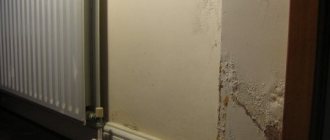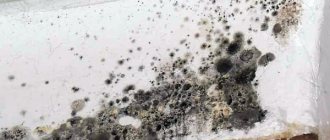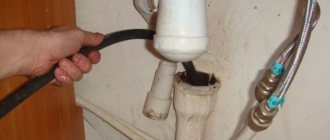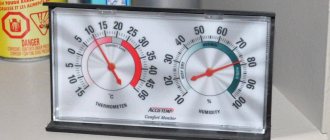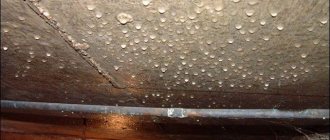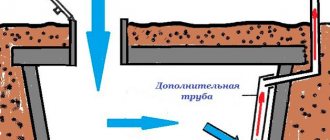The problem of damp corners and walls often worries both residents of high-rise buildings and owners of private houses. Due to the fact that the corner of the room is damp, the walls begin to darken, the wallpaper peels off, mold appears, and the air in the room becomes heavy. Plus, during the cold season, the temperature in the rooms drops, windows are opened less often to ventilate the room, a lot of precipitation falls, and the walls themselves are not dried by the sun's rays.
Damp corners and walls are a fairly serious problem that should be addressed immediately. Damp indoors can cause various diseases and also become a gathering place for fungi and mites.
Therefore, the question of why the corners in the house become damp worries many.
Causes of dampness
The sources of dampness in the corners of rooms can be obvious or hidden. Some are easy to spot, while others will require searching. However, all the reasons why corners in the house are constantly damp are divided into two subcategories - internal (poor ventilation, insufficient heating) and external (increased thermal conductivity of the wall, penetration of water from outside, etc.).
Damp and blackened corner
Dampness often appears in the corners of a room in the following cases:
- the wall is “leaking” (water can enter through cracks in the wall from the attic, drainpipes or eaves);
- the wall freezes (the corners are “crying” because a “cold” bridge has formed due to the increased thermal conductivity of the walls);
- heating in the room is insufficient;
- there is no ventilation or it is ineffective;
- fungus has formed on the walls;
- the foundation of the house is poorly waterproofed;
- there is a lot of washing and drying in the house;
- there are no hoods in the kitchen and bathroom;
- a void has formed in the seams that are not filled with mortar;
- external walls are too thin;
- voids have formed in the floor slabs;
- cooling occurs through metal beams or reinforced concrete structures;
- there is too much water and moisture in the basements;
- balcony slabs are poorly sealed into the wall;
- Condensation appears on ventilation pipes due to improper vapor barrier.
Why do corners in a private house become damp?
The corner of the house is damp and moldy, what should I do? Answers What is the cause of dampness? Formation of condensation on a cold surface.
That is, about 50%, then condensation is still possible, it’s just that the temperature for its formation is needed lower. Solution to the problem: In order for the humidity to be normal, you need to have simple amenities, such as a Hood in the kitchen, etc. These unique inventions do not allow the humidity to go off scale.
If the walls are thin or do not meet thermal standards, then the wall freezes and has a temperature favorable for the formation of condensation.
Good afternoon I ask you for advice! We bought a private brick house in the village with steam heating. All windows are wooden. The previous owner made a brick extension to the house (this is + a corridor + a room + a boiler room where the heating starts.) The gas boiler is an old type, but it works properly.
Everywhere in the house, pipes of the same diameter + additional ones are welded in the middle between the top and bottom.
We applied a penetrating primer in one layer and pasted washable wallpaper everywhere.
Attaching photo. In the next room I’m cooking food (boiler room). I started closing the doors after I realized that steam was condensing on the walls in the form of moisture.
How to eliminate dampness in the corners of the house?
7 7 The problem of damp corners and walls often worries both residents of high-rise buildings and owners of private houses. Due to the fact that the corner of the room is damp, the walls begin to darken, the wallpaper peels off, mold appears, and the air in the room becomes heavy.
Plus, during the cold season, the temperature in the rooms drops, windows are opened less often to ventilate the room, a lot of precipitation falls, and the walls themselves are not dried by the sun's rays.
Damp corners and walls are a fairly serious problem that should be addressed immediately.
Damp indoors can cause various diseases and also become a gathering place for fungi and mites. Therefore, the question of why the corners in the house become damp worries many. The sources of dampness in the corners of rooms can be obvious or hidden.
Why do the walls in a private house become damp?
pages A certain level of humidity is always present in the house: washing, cleaning rooms, washing and even cooking.
Some are easy to spot, while others will require searching. However, all the reasons why corners in the house are constantly damp are divided into two subcategories - internal (poor ventilation, insufficient heating) and external (increased thermal conductivity of the wall, penetration of water from outside, etc.).
But you need to make sure that the humidity does not rise above normal.
The presence of excess humidity in a private home means not only wet walls, moldy corners, unpleasant odors and damaged furniture, but also dysfunction of the respiratory system, allergic diseases and other medical problems. How to determine the optimal humidity level in the house?
This is done using a hygroscope.
The optimal indoor air humidity for comfortable living is considered to be 40–60%.
Exceeding this indicator is fraught with problems in the form of condensation, musty air and fungus.
There are not so many reasons for the appearance of dampness in the house; work to eliminate them is quite accessible to any owner. Reason #1. Improper foundation waterproofing
Why do the corners in the house become damp?
The problem of damp corners and walls often worries both residents of high-rise buildings and owners of private houses. Due to the fact that the corner of the room is damp, the walls begin to darken, the wallpaper peels off, mold appears, and the air in the room becomes heavy.
Plus, during the cold season, the temperature in the rooms drops, windows are opened less often to ventilate the room, a lot of precipitation falls, and the walls themselves are not dried by the sun's rays.
Damp corners and walls are a fairly serious problem that should be addressed immediately.
Damp indoors can cause various diseases and also become a gathering place for fungi and mites. Therefore, the question of why the corners in the house become damp worries many.
- 1 Reasons for the appearance of dampness2 Eliminating dampness in the corners3 Corners on the upper floors of the building become damp4 Preventing the appearance of dampness5 Reducing humidity6 Some nuances of sealing joints7 Waterproofing the foundation8 Condensation after installing new windows9: how to get rid of dampness in a house or apartment Causes of dampness The sources of dampness in the corners of rooms are obvious and hidden.
Construction portal. Honing our skills
When living in a private house, you may encounter dampness under the floor.
This thing is unpleasant and harmful to health.
Underfloor dampness can appear immediately after the house is built or after many years of living in it.
The main reasons leading to its occurrence: Insufficient floor insulation Cracks in the foundation Poorly executed blind area along the outer perimeter of the house Lack of drainage Appearance of moisture in the basement Irregularities in the floor structure Incorrectly installed ventilation in the house
The walls in a private house are getting damp, what to do - How to eliminate dampness in the corners of the house?
- Incorrect installation of double-glazed windows, installation of sealed double-glazed windows or poor-quality seals
- Eduard Guest
- Damp wall
- The main causes of dampness in a private home
- 1
- Poor air ventilation
- What to do
- Where to contact
- Causes of damp walls in the apartment and corners in the rooms: ways to combat mold
- what to do with moisture, where to go, why corners become moldy, what causes a window to get wet
- Why does this happen External moisture
- Wall freezing
- Excessive humidity
- Mold
- Poor air ventilation
- Additional reasons
- What to do
- Where to contact
- Preventing dampness
- The floor and wall in a private house are damp
- Eduard Guest
- Mikhailov Yuri Guest
- How to remove dampness from walls
- Simple useful tips
- The floor and wall in a private house are damp
- causes and solutions
- What should the humidity be?
- Why does moisture form?
- Poor foundation waterproofing
- Poor basement waterproofing
- Incorrect blind area around the house
- Malfunction of the drainage system
- Insufficient or improper insulation of walls and violation of the integrity of the roof
- Insufficient or incorrect ventilation
- Incorrect installation of double-glazed windows, installation of sealed double-glazed windows or poor-quality seals
- Additional reasons
- External moisture
- How to get rid of dampness in the house - follow the main rules!
- Insufficient or incorrect ventilation
- Causes of damp walls in the apartment and corners in the rooms: ways to combat mold
- Who should you contact if there is mold in your home?
- Why does this happen?
- External moisture
- Wall freezing
- Excessive humidity
- Mold
- Poor air ventilation
- Additional reasons
- What to do if the wall in the room is damp
- Preventing dampness
- What should the humidity be?
- Wet wall in an apartment, what to do: advice from professionals
- Wet wall in the apartment - what to do?
- How can I oblige the developer to eliminate a defect if the wall in a new building is damp?
- Excessive humidity
- Eduard Guest
- Mikhailov Yuri Guest
- Malfunction of the drainage system
- Presence of a cold surface
- Insufficient or improper insulation of walls and violation of the integrity of the roof
- How to eliminate dampness and mold on walls, floors, ceilings, in the corners of rooms, in the basement, cellar, house, apartment
- Presence of a cold surface
- High indoor humidity
- The walls in the apartment are damp, what should I do?
- How to remove dampness from walls
- Damp wall
- The floor and wall are damp in a private house Eduard Gost
- Mikhailov Yuri Guest
- Sale of air conditioners:
- How to eliminate dampness and mold on walls, floors, ceilings, in the corners of rooms, in the basement, cellar, house, apartment
- Presence of a cold surface
- High indoor humidity
- Tips on how to remove dampness from walls
- Modern materials for repairing damp walls
- What to do if the wall in the room is damp
- How can I oblige the developer to eliminate a defect if the wall in a new building is damp?
- Wet wall in the apartment - what to do?
- The wall in the apartment gets wet: what to do?
- Who should you contact if there is mold in your home?
- Causes of damp walls in the apartment and corners in the rooms: ways to combat mold
- Wet wall in an apartment, what to do: advice from professionals
- Causes of damp walls in the apartment and corners in the rooms: ways to combat mold
- What to do if the wall in the room is damp
- The floor and wall in a private house are damp
- The wall in the apartment gets wet: what to do?
- Mold
- Modern materials for repairing damp walls
- Poor foundation waterproofing
- Protecting walls from dampness
- Incorrect blind area around the house
- What to do if the wall in the room is damp
- Why does moisture form?
- High indoor humidity
- Poor basement waterproofing
- Sale of air conditioners:
- How to get rid of dampness in the house
- How to get rid of dampness in the house - follow the main rules!
- The main causes of dampness in a private home
- Tips on how to remove dampness from walls
- How to quickly get rid of dampness in the house: ways to eliminate high humidity
- Mikhailov Yuri Guest
- Wall freezing
A corner in a brick house is getting damp, what to do?
pages In houses or apartments, a situation often arises when corners or walls begin to become damp.
As a result, the wall darkens, the wallpaper begins to peel off, and a characteristic smell of dampness appears in the apartment. Such consequences do not add to the attractiveness of the room. But besides this, a damp surface in a room is an ideal environment for the development of mold.
And fungal spores are the cause of the occurrence and development of numerous respiratory tract diseases. What is the reason for the appearance of moisture on the surface of the walls, and how to deal with this problem? What causes dampness in an apartment?
The reasons may be: The cause of dampness may be external moisture falling on the walls and penetrating through microcracks or poorly sealed seams inside.
More often, such a nuisance is typical for apartments on the upper floors with a poor-quality drainage system, for walls along which drainpipes run, as well as panel houses with poorly sealed joints between the slabs.
Wet walls in a brick or panel house: causes and consequences
» Dampness on the walls is a common problem that can appear not only in an apartment, but also in a private house.
It must be addressed immediately, because when the walls and corners become damp, not only the wallpaper begins to darken and peel off, but also mold appears. Dampness on the walls can contribute to the emergence of various diseases and become a gathering place for insects, mites and other fungi.
If the wall in your apartment gets damp, what should you do and where should you go? The reasons for increased humidity on the walls can be different. They are mainly divided into internal and external.
Most often, an apartment gets wet due to the following circumstances: This problem is typical for apartments located on upper floors with a poor drainage system.
Water can enter the walls through microcracks or poorly sealed seams.
Why do the walls in a private house become damp?
/ / 944 Views A frequent problem for many residents of private houses is dampness that forms on the walls and in the corners of houses.
This can cause more serious problems. From banal mold and mildew to the destruction of part of the wall.
To prevent this from happening, it is necessary to notice the problem in time and begin to deal with it. And to successfully combat such an unpleasant phenomenon, you need to correctly determine the cause.
In general, all reasons for the formation of dampness on walls can be divided into external and internal. It depends on which side of the house the problem is on. An example of an external cause would be water entering through cracks in the walls during the rainy season.
Internal causes include those located indoors. This may be poor ventilation of the house or its absence, the presence of fungus in finishing materials, or insufficient heating of the premises.
This classification is rather conditional.
The walls in a private house are damp, what to do?
pages Excessive dampness often becomes a diagnosis of private houses, city high-rises and dachas.
In the cold season, it manifests itself as mold on the walls and windows. Many owners begin and end the fight only with the fungus, because it has a sharply negative effect on the health of the residents. In this case, the root cause - high humidity - is ignored, so the mold soon returns.
Only an analysis of the situation and an integrated approach will help you get rid of dampness. There are several hundred types of household mold in nature.
The main factor in their appearance in a living space is excessive dampness. The fungus forms in places with poor ventilation on surfaces prone to sudden temperature changes. In other words, if there is a cold wall in your house, a dark coating will appear in poorly ventilated corners as soon as you turn on the heating system.
In high-rise buildings, mold can occur due to global disturbances in the air circulation system.
Causes of damp walls in the apartment and corners in the rooms: ways to combat mold
In houses or apartments, a situation often arises when corners or walls begin to become damp.
As a result, the wall darkens, the wallpaper begins to peel off, and a characteristic smell of dampness appears in the apartment. Such consequences do not add to the attractiveness of the room.
But besides this, a damp surface in a room is an ideal environment for the development of mold. And fungal spores are the cause of the occurrence and development of numerous respiratory diseases. What is the reason for the appearance of moisture on the surface of the walls, and how to deal with this problem?
You might also be interested in:
Source: https://nwlb.ru/pochemu-syrejut-ugly-v-chastnom-dome-21625/
Eliminating dampness in corners
Attentive owners will always notice damp corners in time and determine the cause of the appearance of phlegm.
After identifying the culprit of the problem, you can begin to eliminate it:
- If the wall freezes, you need to take measures to insulate it. The most effective way is to insulate the walls from the outside. It will not only reduce dampness, but also reduce heat loss. This is done either with mineral wool or polystyrene foam. However, for owners of apartments in high-rise buildings, such insulation is quite a troublesome task. If problems arise with external insulation, you can insulate the wall inside the room.
When applying insulation from the inside, thermal calculations should be made to avoid the appearance of condensation and moistening of the insulation material, as a result of which its insulating properties are lost.
- To make the correct calculations, the humidity in the room, climate, degree of thermal conductivity of the wall, etc. are taken into account, so in such cases, expert advice is simply necessary.
- If the heating system is inefficient, additional sources of thermal energy should be used. This could be an electric fireplace, a stationary battery, a radiator or other alternative heaters, which are recommended to be installed in places where there is the most dampness.
- If condensation appears due to excessive tightness of the room after installing plastic windows, the room should be ventilated more often.
- If the walls are not thick enough, it is recommended, if possible, to line the outside of the building with an additional ball of brick or apply insulation under the plaster. You can insulate the walls from the inside with slab insulation (foam plastic, mineral wool), placed on the frame with 5 cm wide walls to fill it with expanded clay. This building material will absorb moisture from a damp wall and prevent the spread of mold.
- Ventilation can be improved by installing an additional hood, and at the bottom of the door at the entrance to a separate room you can make a gap to regulate the air. Ventilation should also be improved in the bathroom and kitchen, which are most often sources of dampness.
- If there is a basement underneath the home, moisture can penetrate through microcracks in the floor, causing the walls to become damp. To eliminate this problem, the floor is treated with an antifungal agent, a moisture-resistant base is laid on it, and all cracks are sealed with sealant.
- If the cause of damp corners is fungus and mold that has appeared in the wall on the plaster, then all affected areas are treated with antifungal solutions, plastered again, if necessary, with a high-quality mixture, and only after that new wallpaper is glued.
- If balcony slabs are installed poorly, moisture penetrates into the seams, so the joints between the slab and the wall should be sealed so that there are no leaks that lead to damp spots.
- When caulking seams in external walls, care should be taken to ensure that closed and open joints provide air protection, and that the latter are well protected from moisture.
Why do the corners in the house become damp?
The problem of damp corners and walls often worries both residents of high-rise buildings and owners of private houses.
Due to the fact that the corner of the room is damp, the walls begin to darken, the wallpaper peels off, mold appears, and the air in the room becomes heavy.
Plus, during the cold season, the temperature in the rooms drops, windows are opened less often to ventilate the room, a lot of precipitation falls, and the walls themselves are not dried by the sun's rays.
Damp corners and walls are a fairly serious problem that should be addressed immediately. Damp indoors can cause various diseases and also become a gathering place for fungi and mites.
Therefore, the question of why the corners in the house become damp worries many.
Condensation after installing new windows
It happens that pockets of dampness appear in the corners of an apartment after replacing ordinary windows with plastic ones. The installed windows are very airtight; they tightly close the openings, as a result of which the ventilation of the room deteriorates. You can avoid damp walls in such cases if you know what to do.
Ventilation is often sufficient to exchange air in a room. However, if this is not enough, you can improve ventilation by installing an additional fan on the vent. Then the humidity in the room will decrease, and there will be no condensation of moisture on cold walls, in particular in corners where air exchange is reduced.
The problem of damp corners often becomes a concern during the cold season. Many people don’t even notice damp walls at first, but when the moisture turns into mold, the problem should be taken seriously. Constant dampness in the room causes fungi, mites and centipedes to multiply, and residents may develop various diseases, shortness of breath, cough, and allergic reactions.
The corners on the upper floors of the building are damp
In private houses or on the highest floors, the walls are often damp due to the attic.
This happens in the following cases:
- the corners turn gray due to violations in the insulation of the attic; dampness and black spots appear most of all in places where the attic floor adjoins the external walls;
- the attic space is poorly ventilated (few ventilation holes, no through ventilation); with good ventilation in the attic, the same temperature is maintained over the entire surface of the roof in the autumn-winter season.
Dampness in corners on the top floor
Why is drying the best way to get rid of dampness?
The normal humidity level in a home is 40-60%. If the indicator is below the minimum value, the air is considered too dry, if above the maximum, it is considered too humid. Both are bad for both the person himself and for interior items and decorative coverings located in the room. But if the problem of dry air can be quickly corrected with the help of a humidifier, then with high humidity it is not so simple. Excessive moisture formation requires decisive action, as it can lead to unpleasant consequences: wet walls, mold, damaged furniture, unpleasant odor. In addition, this has a detrimental effect on health: the functions of the respiratory system are disrupted, allergic reactions develop, etc.
Due to high humidity, walls in a private home often become damp. What to do in such a situation? First of all, it is necessary to establish the causes of excess moisture formation. The fact is that there is no point in carrying out any drainage work, and especially repairs, until the source of the increase in humidity is eliminated. Therefore, if dampness is detected in the house, it is necessary to act according to the following algorithm: a) find and eliminate the source; b) call dehumidifiers; c) carry out repair work if required. Employees of Sinus JSC will help you get rid of excess moisture quickly and with a 100% guarantee of results. Call us any time.
Mechanical dehumidification is a more complex and effective process than simply heating the air with heat guns. Drying equipment works on a different principle. It removes excess moisture from all materials, thereby ensuring a normal level of humidity. This drying technique allows you to get rid of the undesirable consequences of excessive moisture formation without harm to decorative coatings and furniture.
Another benefit of mechanical dehumidification is the prevention of mold and mildew growth. If the walls of your home are damp, then there is a high probability of mold growth. Even if you don't see them visually, that doesn't mean they don't exist. If the walls have been exposed to water for a long time, there is a high probability that mold has already begun to grow in them. This process is initially completely invisible to the eye, however, the longer you do not take any preventive measures, the more mold grows.
Drying can not only remove excess moisture, but also destroy the mycelium. When water is removed from the walls, conditions become unsuitable for mold to thrive, as it requires dampness and coolness to thrive. As a result, the mycelium dies. Mold spores are also destroyed, since drying equipment removes them from the air masses and does not allow them to spread further. As a result, dehumidification turns out to be not just an effective way to normalize humidity in a private home, but also an excellent means of preventing the formation of mold and rot.
Often, home owners faced with dampness believe that ventilating or using a heater can correct the problem. Why is this useless in most cases? Because moisture that has penetrated into concrete or brick partitions cannot be removed naturally. Only the outer layer will dry, and only if there are suitable weather conditions and normal humidity outside the window. Moisture that penetrates deep into materials will remain there. As a result, problems with dampness cannot be avoided, as well as all the ensuing consequences.
Preventing the appearance of dampness
Following certain rules will help reduce dampness to a minimum and prevent its occurrence in the future.
- Laundry should be dried outside living rooms or with the hood turned on for air removal.
- When cooking, pots and pans should be covered with lids to prevent steam from escaping.
- In the bathroom, where the highest concentration of humidity is, as well as in the kitchen, hoods and ventilation openings should be regularly cleaned to remove excess debris, and these rooms should also be ventilated daily.
- In a private house, you can insulate the attic and also cover the walls with a waterproofing material, preferably with pores.
- All flammable substances that form a lot of moisture, in particular paraffin, should be used extremely rarely indoors.
- All rooms in the house should be ventilated daily.
- Correct errors in the heating system in a timely manner.
- Use a dehumidifier to reduce humidity. This household appliance can easily cope with the problem of dampness, and its compactness allows you to move the dehumidifier from room to room.
Preventing dampness
To prevent the walls from becoming damp again, it is necessary to reduce the amount of incoming moisture. For this:
- do not dry clothes inside the apartment, use a balcony or loggia;
- keep the ventilation grilles clean;
- at the lowest outside temperatures, use additional heating devices;
- in a private house, insulate the attic and ensure its ventilation;
- Ventilate the premises more often.
Install a fan with a built-in humidity controller on your bathroom hood. When the moisture content in the air increases, it will turn on automatically.
Source
Reducing humidity
If walls often get wet in interior rooms with high moisture (bathhouse, bathroom), then the problem is most likely in the ventilation system. Therefore, first of all, you should check the ventilation openings for the presence of unnecessary objects that may interfere with air circulation.
It’s easy to check how clogged the ventilation channels are: hold a burning candle to the vent and watch how the flame reacts: if it reaches towards the grate, then the channels are not clogged and there is a draft. When there is no flame response to ventilation, additional devices need to be installed in order to establish air circulation.
When the holes are not clogged, but the draft is still weak, additional slots can be made at the bottom of the door for air intake. If this does not help, a forced exhaust is installed in the ventilation duct. Such fans are turned on only when there are no people in the room, as they can seriously harm your health.
Experts advise installing fans with a built-in humidity controller in the bathroom. When humidity rises, the fan operates automatically, eliminating air oversaturated with dampness.
Some nuances of sealing joints
If the tightness of the seams is broken and cracks appear in the walls, the corners in the room begin to become damp. In this state of affairs, there is only one way out: the waterproofing of the joints between the panels needs to be repaired, and microcracks in the walls need to be repaired.
After high-quality sealing, the walls should not gain moisture. They can become damp and leak only when the technology for sealing the seams is broken.
The main mistakes are applying sealant without prior repair or using a low-quality sealant.
This should also be taken into account: if waterproofing of joints is carried out in one apartment, and not in the whole house, then the problem of dampness will not disappear. Moisture will penetrate into poorly sealed seams in an apartment on the floor above or on the technical floor, so although more slowly, it will find its way into the desired room.
Foundation waterproofing
It happens that dampness in the house is caused by the fact that the foundation is poorly insulated. If its waterproofing is insufficient, groundwater when raised above 1.5 m can penetrate into the walls. In this case, they will get wet, mold will appear under the baseboard and in the corners, the plaster will begin to fall off, and the wallpaper will deteriorate. However, if horizontal waterproofing of the foundation is done correctly, it can prevent the penetration of groundwater.
Why does the foundation get wet?
Causes of dampness in a private home
There are not so many reasons for the appearance of dampness in the house; work to eliminate them is quite accessible to any owner.
Reason #1. Improper foundation waterproofing
This means that when laying the foundation, violations were made when arranging horizontal waterproofing. Now the impact of groundwater leads to gray-green stripes under the baseboard, damp wallpaper that is falling off at the bottom, and moldy corners.
To change the situation, it is necessary to develop the soil around the perimeter of the foundation and apply vertical waterproofing of the foundation walls. This will not be easy or cheap, but there are no other technical processes that guarantee complete elimination of dampness.
Reason #2. Violations in the waterproofing of the basement
waterproofing a basement 4
This is usually caused by errors in basement waterproofing. Groundwater, affecting the floor, walls and ceiling of the basement, leads to the formation of dampness in the rooms above the basement. Moreover, groundwater can flood the basement. Then, after pumping out the liquid, you will have to carry out vertical waterproofing of the walls, as in the first case.
If there is no water in the basement, but only dampness, then coating and injection waterproofing will help. All basement surfaces must be treated.
Condensation after installing new windows
It happens that pockets of dampness appear in the corners of an apartment after replacing ordinary windows with plastic ones. The installed windows are very airtight; they tightly close the openings, as a result of which the ventilation of the room deteriorates. You can avoid damp walls in such cases if you know what to do.
Ventilation is often sufficient to exchange air in a room. However, if this is not enough, you can improve ventilation by installing an additional fan on the vent. Then the humidity in the room will decrease, and there will be no condensation of moisture on cold walls, in particular in corners where air exchange is reduced.
The problem of damp corners often becomes a concern during the cold season. Many people don’t even notice damp walls at first, but when the moisture turns into mold, the problem should be taken seriously. Constant dampness in the room causes fungi, mites and centipedes to multiply, and residents may develop various diseases, shortness of breath, cough, and allergic reactions.
Why do the walls in a private house get wet and how to fix it?
With the onset of cold weather, many owners of private houses are faced with the problem of a wet wall, most often in the corners. Many people do not pay due attention to this issue, but this moisture can turn into mold in the future, and after this the owner may have all sorts of problems, primarily a cough or an allergic reaction.
Video: how to get rid of dampness in a house or apartment
The fight against excess moisture in a living space must begin immediately. This process is quite labor-intensive and sometimes requires money. However, with an accurate determination of the root cause of the increase in humidity and the correct choice of effective ways to combat dampness, you can forget about wet corners forever. And if necessary, new renovations in the apartment will refresh the walls and please everyone.
Dampness on the walls is a common problem that can appear not only in an apartment, but also in a private house. It must be addressed immediately, because when the walls and corners become damp, not only the wallpaper begins to darken and peel off, but also mold appears.
Dampness on the walls can contribute to the emergence of various diseases, and become a gathering place for insects, mites and other fungi . If the wall in your apartment becomes damp, what should you do and where should you go?
Why do the walls in a private house become damp?
Apartment and dacha Comments on the entry Why do the walls in a private house become damp? disabled 944 Views
A common problem for many residents of private houses is dampness that forms on the walls and in the corners of houses. This can cause more serious problems. From banal mold and mildew to the destruction of part of the wall.
To prevent this from happening, it is necessary to notice the problem in time and begin to deal with it. And to successfully combat such an unpleasant phenomenon, you need to correctly determine the cause.
Why does this happen?
The reasons for increased humidity on the walls can be different. They are mainly divided into internal and external. Most often, the apartment gets wet due to the following circumstances:
External moisture
This problem is typical for apartments located on upper floors with a poor drainage system.
Water can enter the walls through microcracks or poorly sealed seams. The wall can also become damp due to a drainpipe passing nearby.
To get rid of this problem, you will have to clean the walls from the damp coating, plaster them, prime them, and cover them with waterproofing mastic.
Such actions can be done independently either in a private house or in an apartment on the ground floor. In other cases, you will have to seek help from specialists.
Wall freezing
This phenomenon occurs when the temperature outside is too low and the air inside the room is not warm enough. Because of this, the walls begin to freeze, and moisture appears on its inner surface.
The wall can also freeze due to the presence of microcracks or leaky joints. To eliminate this problem, sometimes it is enough to increase the temperature in the room, but the most effective way is to additionally insulate the walls. In this case, it is better to give preference to exterior decoration.
Excessive humidity
If we are talking about a brick building, then a large amount of moisture is formed due to the basement. In other cases, replacing windows in the apartment can contribute to the appearance of pockets of dampness. This is explained by the fact that the installed plastic windows are very sealed and close the openings too tightly, so the ventilation of the room deteriorates.
As a result, condensation appears and the windows sweat. Sometimes it is enough to ventilate the room to avoid this problem. If it is not resolved, then you can try to improve the operation of the ventilation system.
External moisture
The cause of dampness can be external moisture falling on the walls and penetrating through microcracks or poorly sealed seams inside. More often, such a nuisance is typical for apartments on the upper floors with a poor-quality drainage system, for walls along which drainpipes run, as well as panel houses with poorly sealed joints between the slabs.
moisture in corners
In order to eliminate the problem, it is necessary to clean the wall of the old coating, re-plaster it from the outside, prime it, cover it with waterproofing mastic, and only then completely paint the resulting surface. You can independently carry out such a cycle of operations either in a private house or on the first floor of an apartment building. In other cases, solving the problem of damp walls on your own will be very problematic due to the need to carry out high-altitude work. Therefore, you will have to turn to professionals.
What to do
Having found out the reason why the walls get wet, the question arises of eliminating excess moisture.
If such a situation arose after renovation, then it is enough to ventilate the rooms more often. If this is a cold period of time, then it is important that the room is warm enough.
If the batteries are not enough, you can use additional heaters. When the problem lies in ventilation, you can try to remove foreign objects that interfere with normal air circulation.
Insufficient waterproofing is a more complex situation. Eliminating the problem consists only of finding the area where the water comes from and isolating it well. The main source is seams on the outside of the house. This task should only be solved by specialists.
Where to contact
If all possible options for eliminating dampness do not help, then you need to write a statement and submit it to the management company. It is drawn up in writing and in two copies. The paper should contain detailed information about when the corners or walls began to get wet, and an exact indication of the location.
ATTENTION! After submitting your application, it is important to ensure that it is recorded. The applicant must keep one copy with a mark.
The next action of the management company should be to send a technician to inspect the residential premises, based on the results of which a report on the presence of dampness and the reasons for its occurrence will be drawn up. The apartment owner must request a copy of this document.
As soon as the act is drawn up, the management company must decide on the option for repair work, as well as the time frame by which it will be completed. It is advisable for the apartment owner to take a copy of each document. If the repairs are not carried out or the period is significantly delayed, then these copies can be contacted with the relevant authorities.
Where to go when the walls become damp
Before contacting utility services, you need to determine the cause of the dampness. If you can’t do this yourself, you can call a specialist from the organization managing the apartment building. Before starting work, a report is drawn up. It is issued in the presence of the owner of the apartment, two witnesses and a representative of the organization. This document can be submitted to any other authorities.
If the activities of the management company are not the cause of dampness on the walls, then you will have to hire private craftsmen. In another case, a written claim or complaint is submitted to the housing maintenance office. The organization must review it and respond within a week. After this, specialists should begin to fix the problem.
If the management company refuses to carry out repairs, it will notify the applicant in writing. When inspecting an apartment, a specialist can determine that dampness appears due to the action or inaction of the operating organization; the affected party can contact the following authorities:
- Housing Inspection;
- Rospotrebnadzor;
- Prosecutor's Office;
- Local administration.
The complaint must be properly formatted. In accordance with the law, it can be submitted to several authorities simultaneously. The last thing the applicant does is go to court.
Dampness in the house is not only unpleasant, but also dangerous to health. It will not be possible to cope with it without finding out the cause. You can deal with the problem yourself or with the help of repair organizations.
The problem of damp corners and walls often worries both residents of high-rise buildings and owners of private houses. Due to the fact that the corner of the room is damp, the walls begin to darken, the wallpaper peels off, mold appears, and the air in the room becomes heavy. Plus, during the cold season, the temperature in the rooms drops, windows are opened less often to ventilate the room, a lot of precipitation falls, and the walls themselves are not dried by the sun's rays.
Damp corners and walls are a fairly serious problem that should be addressed immediately. Damp indoors can cause various diseases and also become a gathering place for fungi and mites.
Therefore, the question of why the corners in the house become damp worries many.
Preventing dampness
If certain recommendations are followed, the appearance of dampness can be prevented or minimized. Basic Rules:
- It is advisable to dry laundry outside the living room or with the hood running.
- During cooking, the dishes must be covered with a lid to prevent steam from escaping from them.
- In the bathroom, where the highest concentration of moisture is contained, as well as in the kitchen, you need to periodically clean the ventilation openings from clogging. Also, these rooms require systematic ventilation.
- In a private house, you can try to insulate the attic space. In addition, you can cover the walls with waterproofing material.
- It is recommended to use flammable substances less frequently, such as paraffin, which contributes to the appearance of moisture.
- Correct errors in the heating system in a timely manner.
- You can use a dehumidifier to reduce humidity. This device easily fixes the problem. It is also quite compact, which makes it easy to move it to different rooms.
Experts recommend installing fans with a built-in humidity controller in the bathroom. If the humidity rises, it reacts automatically, eliminating excess moisture in the air.
ATTENTION! It is important to monitor the condition of the apartment and prevent the walls from becoming damp.
The fight against excess dampness in an apartment or in an individual residential building cannot be postponed until later. It must be started immediately, as this is a rather labor-intensive process, sometimes requiring financial costs.
If you accurately determine the cause and choose the right method to eliminate it, then you can forget about dampness for a long time.
Why do corners in the house become damp?
Damp wall
Dampness on the walls can appear for several reasons. The main indicator of dampness in a wall is mold. A damp wall is formed from three main reasons:
- External leaks
- Poor thermal insulation
- Lack of ventilation
Dampness on the walls creates a favorable environment for the growth of mold and creates an unfavorable environment for human habitation. The main negative factors of damp walls in a room are:
- Heat leakage and increased energy consumption for heating a room with damp walls.
- Active reproduction of fungal and mold spores.
- Decreased immunity and exacerbation of chronic diseases of the human body due to uncomfortable temperature and humidity conditions in the room and the active reproduction of fungal and mold spores.
Our specialist will help you correctly determine the cause and give further recommendations - how to remove dampness from the walls and how to treat the walls against dampness. Determining on your own the reasons why your wall is damp, without the appropriate equipment, can lead you down the wrong path of further action. Savings on diagnostics will definitely affect your wallet, since any construction work to eliminate dampness in our time is not very cheap.
Protecting walls from dampness
Let's look at the three main places where the problem of dampness on walls is most often encountered:
- Damp wall in the apartment.
- Damp wall in the house
- Damp wall in the basement
The floor and wall in a private house are damp
In this case, repairs are useless, since all your attempts will be actively destroyed by the mold that has arisen in the walls.
In what ways can you speed up the drying of walls and ceilings after localizing external leaks?
Washed laundry always dries faster where there is active ventilation and less air humidity. The same principle applies to dampness in the walls. In rooms with damp walls after external leaks, it is necessary to create a mode of active ventilation and lower air humidity. How to create such a mode? In summer, when the weather is hot, it is enough to keep the windows constantly open, creating a draft in the rooms. In all other cases, such a regime will have to be created artificially, using special air dryers.
How long will it take to dry damp walls like this?
It all depends on several factors: what material the walls are made of, how thick they are, and how wet they are. To speed up the drying process of damp walls after localizing external leaks, it is necessary to remove wet wallpaper and old plaster from the walls, which will create an active obstacle to the ventilation of the wall surface.
Is it possible to further intensify the drying of walls and speed up repairs after localizing external leaks?
Yes you can. On the market of modern building materials, there are environmentally friendly capillary active sanitizing heat-insulating plasters of the THERMO series, which perform very important necessary functions - they constantly artificially draw moisture from the walls, drying them and preventing the possibility of the formation of fungus and mold. In addition to the properties described above, the thermal insulating sanitizing plasters of the THERMO series additionally have the following properties: durable, non-flammable, moisture-resistant, inert in aggressive environments, have excellent sound absorption that prevents the occurrence of echoes, as well as high vapor permeability and adhesion to all building materials, including glass In short, by using the sanitizing heat-insulating plaster of the THERMO series in repair work at the stage of incomplete drying of the wall, you do not risk ruining your repair, since thanks to its unique hydrophobic and air-permeable properties, Thermo plaster helps remove moisture from the building structure.
Dampness in the walls of the apartment communicating with the street.
If one wall or several walls of your apartment face the street and these walls are constantly wet, then two reasons for dampness in the walls can be considered - either poor waterproofing of the outer surface of the wall, or insufficient thermal insulation of the wall.
In the first case, to restore the waterproofing of the outer surface of the wall communicating with the street, it is necessary to use special water repellents
.
which create a protective water-repellent coating on the wall surface. The water repellent
is inexpensive, and it is quite simple to apply by spraying it on the wall. The main problem can only arise in the performer of the work, since in most cases such work must be performed at high altitudes.
In the second case, to insulate the wall, it is necessary to decide on which side the wall will be insulated from the outside or from the inside? For external wall insulation, it is necessary to resort to the help of third-party organizations specializing in high-altitude work. This solution to the problem is often unacceptable, since no one wants to pay for expensive work. However, if you still decide to externally insulate the apartment wall, we recommend that you use either Teplomet-Facade
.
or heat-insulating sanitizing plasters of the THERMO series.
Teplomet liquid-ceramic thermal insulation
.
or heat-insulating sanitizing plaster of the THERMO
.
What is the difference between Teplomet and THERMO?
Liquid-ceramic thermal insulation Teplomet
It is most convenient to apply when the wall is in its driest state.
This usually happens in the summer. Teplomet
liquid thermal insulation is extremely simple and you can handle this work yourself.
You can
more about the properties of Teplomet here...
As for the thermal insulating sanitizing plaster of the THERMO series,
then you can’t do without it if your wall is in a damp state at the time of starting work on insulation from the inside of the apartment.
Thanks to its unique hydrophobic and breathable properties, Thermo
helps remove moisture from damp walls while insulating them.
However, the technology for applying thermal insulating sanitizing plaster of the THERMO
is more complex than the liquid thermal insulation technology
Teplomet
.
And here you will have to resort to the help of a qualified specialist, which will certainly affect the cost of work on insulating the wall from inside the apartment. more about the properties of THERMO
and the technology of its application
here...
Eduard Guest
Why do the walls in the house sweat and get wet and how to fix it
With the onset of cold weather, many residents of apartments and houses are faced with the problem of wet walls, especially in the corners. Some people do not attach any importance to this, but subsequently this moisture gradually develops into mold, and then health problems may arise for residents, such as frequent coughing and various illnesses, shortness of breath, allergies, etc.
The problem of wet walls in the house must be taken very seriously, and if you neglect it, the consequences can be disastrous.
If the fogging of the walls has already developed into the formation of mold, then ordinary scraping is not enough, since after a short period of time it will again grow on the wall, no matter what you treat it with. Here we need to look for other solutions, and specifically, get rid of moisture in the walls.
In order to find a solution to the problem, it is necessary to determine its source, and in a particular case, find the reason why the walls in the house are sweating and getting wet.
Why the walls in the house become wet and how to deal with it
First you need to determine the source of moisture. There may be several options; we will consider each one separately.
Freezing of the outer wall of a house or apartment
This option most likely applies to old houses, because previously they only dreamed of good insulation during construction. Or, when building a house, they saved a lot on insulation, relying on a large number of batteries.
Signs: The house is constantly cold and damp in winter. The walls inside the room are very cold. A lot of energy is spent on heating in winter.
Why does this happen: In severe frosts, the dew point in the wall moves closer to the room, and if there is insufficient heating, the wall begins to sweat. In this case, we need to move the dew point closer to the street.
How to fix: In this case, you have two options, the first is to heat the room more strongly, but this is an additional monetary expense with dubious benefits, and the second is to insulate the walls of the house from the outside. To do this, you can try to insulate the walls with polystyrene foam, for example. In these circumstances, thermal insulation of the wall from the inside of the house will not help, but on the contrary, will worsen the situation.
In this case, we will shift the dew point even closer to the room. There will be even more moisture on the wall itself under the insulation, and it will gradually turn into puddles on the floor. Only external wall insulation can help here. With external insulation we will shift the dew point in the direction we need, as can be seen in the diagram. It's not very cheap, but it's reliable. And of course, keep an eye on the ventilation.
Without ventilation, wet walls cannot be avoided.
The wall gets wet due to insufficient waterproofing
This option, in most cases, applies to those who live on the top or first floors of houses. If the wall is wet below, then moisture can enter from the street through the basement, through the floor, basement, if there is insufficient waterproofing in those places. If the wall in the house gets wet or sweats at the top, most likely moisture enters through the roof, which is poorly insulated from water.
Signs: The largest stains on the walls are in the fall, in damp weather, or in the spring, when the snow begins to melt. If the room is well heated, then at subzero temperatures, wet spots will dry out slowly.
Why does this happen: If the roof is of poor quality, water will always find a loophole and get inside the room. How does it rise to the top if the floor is poorly waterproofed? The fact is that whether it is concrete, brick or building block, all these materials have a very bad property - to absorb moisture. The base, for example, can lift moisture from the ground by almost a meter. This is why waterproofing between the wall of the house and the base is so important.
How to fix: In this case, you have only one way out. Find the place through which water gets inside the wall, and do better waterproofing, or insulate the base from the outside, if this is the case. Inspecting a house from the street will yield more results than looking for a solution from the inside. And of course, ventilation or frequent airing of the room will in many cases reduce the likelihood of problems with wet walls.
Poor ventilation of the room or part of it
This is a very common occurrence when the ventilation in the house is not sufficiently calculated or does not work well. Even if it is in good condition, there are still corners in the house in which it “does not work”, and over time they begin to sweat.
Signs: If there is a general problem with ventilation, windows may become heavily fogged. In local cases, the wall in the house gets wet behind a curtain, or behind some objects that prevent air recirculation near the wall, while the rest of the walls are completely dry.
Why this happens: If there is insufficient ventilation, no matter what you do, moisture will accumulate on the walls. In fact, there is enough moisture in the room for this, even if it seems that the air is dry.
How to fix: If there is a general problem with ventilation, it is necessary to solve it. There must be circulation in the house. If there is a local problem in certain places, remove objects that interfere with circulation.
Recently renovated
If everything was fine before the renovation, but immediately after the renovation the walls in the house suddenly become wet, then there is nothing to worry about and this is a common occurrence.
Signs: The windows in the house sweat a lot.
Why does this happen: When you make a major repair using plaster, putty or other materials that contain water, the walls begin to absorb this moisture and this cannot be avoided. The repair is complete, everything seems to be dry, but the moisture in the wall will remain for some time in any case. In addition to this, if you did not ventilate the room enough during the renovation, a huge amount of moisture will be in the air.
How to fix: During repairs, it is necessary to ventilate the room, and during the cold period it is also necessary to heat it sufficiently. In this case, the walls will soon dry out.

